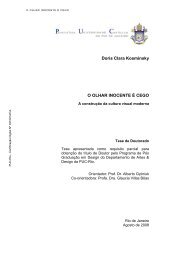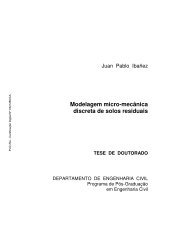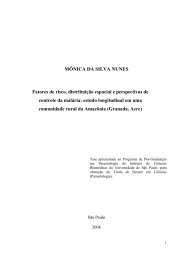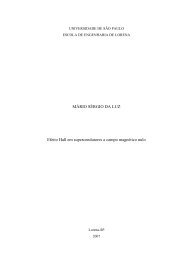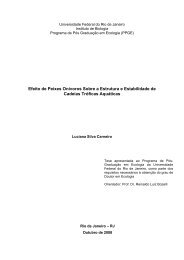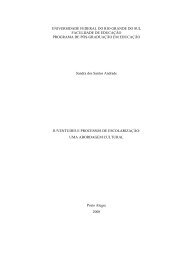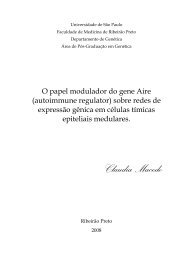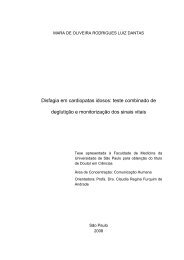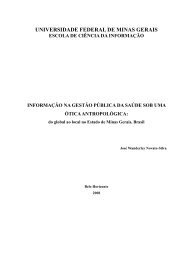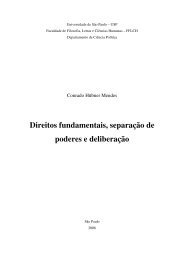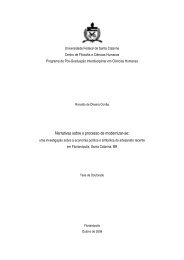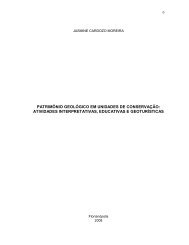Liquid Crystals, Vol. 33, No. 4, April 2006, 381–390Synthesis and characterization of luminescent hockey stick-shapedliquid crystalline compoundsRODRIGO CRISTIANO, ANDRÉ ALEXANDRE VIEIRA, FERNANDO ELY and HUGO GALLARDO*Departamento de Química, Universidade Federal de Santa Catarina, CEP 88040-900, Florianópolis, SC, Brazil(Received 15 July 2005; accepted 13 October 2005 )A general synthetic strategy, based on a convergent approach, allowed us to prepare a seriesof luminescent unsymmetrical bent-core compounds (2,5-(disubstituted)-1,3,4-oxadiazolederivatives), via the Sonogashira crosscoupling reaction, all possessing a similar hockey stickshape. Their mesophases were characterized using polarizing optical microscopy anddifferential scanning calorimetry. The observed LC phases possess the classical textures ofcalamitic liquid crystals. Fluorescence in solution for these compounds exhibits strong blueemission (l max em. 5390–460 nm) with good quantum yields (50–85%).1. IntroductionThe design of novel thermotropic liquid crystals asadvanced functional materials involves suitable selectionof a core fragment, linking group, and terminalfunctionality. However, anisometric rodlike- ordisklike-shaped molecules used to be a fundamentalprerequisite for conventional thermotropic liquid crystalformation, because steric packing considerationsplay an important role in this interesting state of softmatter [1]. More recently, with the discovery of bananashapedliquid crystals, where bent molecules serve as acore, interest in the incorporation of nonlinear units hasgained importance. The study of the mesomorphicproperties of these compounds, which has gainedconsiderable importance since the discovery of polarswitching in such achiral compounds, and the subsequentdetailed analysis of the switching process [2], aremainly driven by their potential for application indisplay technology [3, 4]. A large number of bent-coreor banana-shaped mesogens have been synthesized toexamine their novel mesophase structures [5–7]. Most ofthe compounds reported in the literature are symmetricalaround a central phenyl ring and are derived from1,3-dihydroxybenzene or 2,7-dihydroxynaphthalene [8,9]. Usually these are five- or six-ring compounds andare substituted with two terminal alkyl/alkoxy chains.In recent years a wide range of emissive materials hasbeen reported for use in electroluminescent (EL)devices; these vary from low molecular mass moleculesto processable polymers [10]. In addition, highly*Corresponding author. Email: hugo@qmc.ufsc.brconjugated liquid crystals are desirable as the selforganizingproperties of these materials can be exploitedto improve device performance and to achieve linearlypolarized electroluminescence [11]. For example,Contoret et al. [12] have reported polarized electroluminescencefrom a nematic network, offering a possiblesubstitute for one of the polarizers and the back light ofTN-LCDs and STN-LCDs, with a lower power consumptionand/or a higher brightness. Among otherimportant aspects are their high charge carrier mobilityobserved in hexagonal discotic (Col h ), helical (H) andsmectic A, B phases and an unidentified smectic X phase[13], and their ability to develop defect-free layers [14].Functional LCs can be obtained by incorporating newproperties into the same molecule, besides its inherentself-organization, such as luminescence. This combinationhas led to intrinsically luminescent mesogens, whichare able to form ordered aggregates with large carriermobilities for EL devices. In this context, our interest hasbeen focused on luminescent liquid crystals containingthe heterocycle 1,3,4-oxadiazole [15, 16]. 1,3,4-Oxadiazole derivatives are well known for their highthermal and hydrolytic stability, resistance to oxidativedegradation and electron-accepting properties [17]. Theyusually exhibit a high photoluminescent quantum yield[18]. The introduction of an oxadiazole ring into amesogenic core can provide a lateral dipole from oxygenand nitrogen atoms and also a bent rigid core [19].In this paper, we report the synthesis, mesomorphicbehaviour and photophysical properties ofseveral unsymmetrical bent-core compounds basedon 2-(4-decyloxyphenyl)-5-(4-phenylethynylaryl)-1,3,4-oxadiazole (figure 1).Liquid CrystalsISSN 0267-8292 print/ISSN 1366-5855 online # 2006 Taylor & Francishttp://www.tandf.co.uk/journalsDOI: 10.1080/02678290500483304
382 R. Cristiano et al.acetylenes 10–16 were synthesized from aryl halides bythe sequence of alkylation, palladium- catalysed crosscoupling(Sonogashira coupling [21]), with 2-methyl-3-butyn-2-ol followed by protective group elimination.The final step was the Sonogashira coupling betweenaryl bromide 9 and the terminal aryl acetylenes toafford compounds 1–7.Compounds 1, 2, 3, 5 and 6 were obtained in goodand moderate yields; see table 1. However, for compounds4 and 7 this adopted route only gave traces ofthe product with a considerable amount of homocouplingproduct. The synthesis of these compoundswas therefore possible by simply reversing the functionalitiesaccording to scheme 2.2.2. Mesophases and thermal propertiesFigure 1. Chemical structures of the final synthesizedmolecules.All the compounds were designed with two unsymmetricalarms about a central 1,3,4-oxadiazole ringstructure possessing a similar hockey stick shape [20]. Inorder to contribute to an understanding of the underlyingstructure–property relationships, different aromaticmoieties were used to elongate one of the arms ofthe hockey stick, such as: phenyl with a differentaliphatic long chain (7, 10 and 12 carbon atoms),biphenyl, naphthyl, phenylpiperazine and phenyl benzoate.These aromatic moieties are linked to the mesogeniccore through a triple C;C bond in order to produce ahighly p-polarizable and conjugated diarylacetylenemoiety.2. Results and discussion2.1. SynthesisThe initial synthetic route to the final liquid crystallinematerials 1–7 was carried out according to scheme 1.1,3,4-Oxadiazole-based aryl bromide 9 was preparedfrom aryl tetrazole 8 and 4-bromobenzoyl chloridethrough the Huisgen reaction. The terminal arylThe transition temperatures, phase assignments andthermal stabilities of the final compounds were investigatedby thermal polarizing optical microscopy(POM), DSC and TGA; the results are given in table 2.All the materials studied exhibited high thermal stabilitywith decomposition temperatures between 390 and470uC, and showed smectic and nematic phases typicalfor calamitic liquid crystals.In order to establish the effects of varying theterminal alkoxy chain length on the mesomorphicbehaviour, three homologues (compounds 1–3) weresynthesized and their mesomorphic behaviour characterized.The optical observations were performed usingclean untreated glass slides. For these compounds it isclear that the SmC phase stability increases with theelongation of the terminal alkyl chain. The first member1, having a heptoxy chain, exhibits only an enantiotropicN phase that was identified from the observationof a characteristic schlieren texture. For homologue 2,with a decyloxy chain, dimorphism was observed,exhibiting an enantiotropic N phase and a monotropicSmC phase, while homologue 3 showed the twoenantiotropic phases. The presence of the SmC phasewas confirmed from the microscopic observation of thecharacteristic striated texture immediately after the N–SmC transition, followed by the appearance of a brokenfan-shaped texture.With the addition of a further phenyl ring (compound4) there is an increase in the melting point (221.9uC)with short SmC and N ranges. However, the naphthaleneunit in compound 5 leads to a lower melting pointwith more stable SmC and N phases. On cooling,crystallization starts at only 126.8uC. Compound 6exhibits a trimorphism SmA, SmC and N phases. Thepresence of the SmA phase was confirmed from themicroscopic observations, the phase separates out inthe form of bâtonnets which coalesce and build up
- Page 2 and 3:
AUTOBIOGRAFIARodrigo Cristiano nasc
- Page 5 and 6:
Rodrigo CristianoMATERIAIS MOLECULA
- Page 7 and 8:
À minha esposa Cláudia.
- Page 9 and 10:
VÍNDICEINTRODUÇÃO ..............
- Page 11 and 12:
VIILISTA DE FIGURASFigura 1. Proces
- Page 13 and 14:
IXFigura 31. Espectro de RMN de 1 H
- Page 15 and 16:
XIFigura 63. Espectros de (a) UV e
- Page 17 and 18:
XIIILISTA DE TABELASTabela 1. Os ti
- Page 19 and 20:
XVTGA - Análise termogravimétrica
- Page 21 and 22:
XVIIABSTRACTThe synthesis and chara
- Page 23 and 24:
Introdução 19A química orgânica
- Page 25 and 26:
Introdução 21fenômenos possuem t
- Page 27 and 28:
Introdução 23elétrico é aplicad
- Page 29 and 30:
Introdução 25(Figura 3). A verdad
- Page 31 and 32:
Introdução 27investigar a conexã
- Page 33 and 34:
Introdução 29com um banco de dado
- Page 35 and 36:
Introdução 31descrever a estrutur
- Page 37 and 38:
Introdução 33Nas fases esméticas
- Page 39 and 40:
Introdução 35OHC 6 H 13OOOC 11 H
- Page 41 and 42:
Introdução 37O interesse na sínt
- Page 43 and 44:
Introdução 39Figura 17. Represent
- Page 45 and 46:
Introdução 41Figura 19. Esquema d
- Page 47 and 48:
Introdução 43mais comum nesses ma
- Page 49 and 50:
Introdução 45formam estruturas su
- Page 51 and 52:
Introdução 47do material quando n
- Page 53 and 54:
Introdução 491,3,4-oxadiazolN NOO
- Page 55 and 56:
Introdução 51R 2 OR 1OR 2N N ONON
- Page 57 and 58:
Introdução 53estável através de
- Page 59 and 60:
RESULTADOS EDISCUSSÃO
- Page 61 and 62:
Resultados e Discussão 57aromátic
- Page 63 and 64:
Resultados e Discussão 59Esquema 3
- Page 65 and 66:
Resultados e Discussão 61mantendo-
- Page 67 and 68:
Resultados e Discussão 63(ν C≡C
- Page 69 and 70:
Resultados e Discussão 65funcional
- Page 71 and 72:
Resultados e Discussão 67ROORROOO4
- Page 73 and 74:
Resultados e Discussão 69Uma rota
- Page 75 and 76:
Resultados e Discussão 71baNNOc d
- Page 77 and 78:
Resultados e Discussão 73Tabela 3.
- Page 79 and 80:
Resultados e Discussão 75Para o co
- Page 81 and 82:
Resultados e Discussão 77porque o
- Page 83 and 84:
Resultados e Discussão 795. CLs cu
- Page 85 and 86:
Resultados e Discussão 81gerado a
- Page 87 and 88:
Resultados e Discussão 835.2. Prop
- Page 89 and 90:
Resultados e Discussão 85(a)Cr-CrC
- Page 91 and 92:
Resultados e Discussão 87(a)(b)Fig
- Page 93 and 94:
Resultados e Discussão 89Esses com
- Page 95 and 96:
Resultados e Discussão 91catalíti
- Page 97 and 98:
Resultados e Discussão 93a complet
- Page 99 and 100:
Resultados e Discussão 95A banda l
- Page 101 and 102:
Resultados e Discussão 97constante
- Page 103 and 104:
Resultados e Discussão 99A não-pl
- Page 105 and 106:
Resultados e Discussão 101(a)(b)T
- Page 107 and 108:
Resultados e Discussão 103(e)trans
- Page 109 and 110:
Resultados e Discussão 1056.5. Pro
- Page 111 and 112:
Resultados e Discussão 107composto
- Page 113 and 114:
Resultados e Discussão 109composto
- Page 115 and 116:
Resultados e Discussão 1117. Tris-
- Page 117 and 118:
Resultados e Discussão 113Esquema
- Page 119 and 120:
Resultados e Discussão 115A caract
- Page 121 and 122:
Resultados e Discussão 117ppm rela
- Page 123 and 124:
Resultados e Discussão 1197.2. Est
- Page 125 and 126:
Resultados e Discussão 121Figura 7
- Page 127 and 128:
Resultados e Discussão 123N21-N22
- Page 129 and 130:
Resultados e Discussão 125método
- Page 131 and 132:
Resultados e Discussão 127após lo
- Page 133 and 134:
Resultados e Discussão 129baseado
- Page 135 and 136:
Resultados e Discussão 131aquecime
- Page 137 and 138:
Resultados e Discussão 133composto
- Page 139 and 140:
Resultados e Discussão 1357.5. Est
- Page 141 and 142:
Resultados e Discussão 137estabili
- Page 143 and 144:
Conclusões 1398. CONCLUSÕESEm ger
- Page 145 and 146:
SEÇAO EXPERIMENTAL
- Page 147 and 148:
Seção Experimental 143respectivam
- Page 149 and 150:
Seção Experimental 1457,08 (m, 2H
- Page 151 and 152: Seção Experimental 147K 2 CO 3 (7
- Page 153 and 154: Seção Experimental 149H, -CH 2 NC
- Page 155 and 156: Seção Experimental 1512918, 2851,
- Page 157 and 158: Seção Experimental 153Esse compos
- Page 159 and 160: Seção Experimental 155Espectro de
- Page 161 and 162: Seção Experimental 157Este compos
- Page 163 and 164: Seção Experimental 159H 21 C 10 O
- Page 165 and 166: Seção Experimental 16114,36; 22,9
- Page 167 and 168: Seção Experimental 163H), 6,85 (d
- Page 169 and 170: Seção Experimental 165NCNCNNHO59O
- Page 171 and 172: Seção Experimental 167H 21 C 10 O
- Page 173 and 174: Seção Experimental 169(sílica-ge
- Page 175 and 176: Seção Experimental 171dodeciloxib
- Page 177 and 178: Seção Experimental 173NCNCNNOOOOC
- Page 179 and 180: Seção Experimental 175Análise el
- Page 181 and 182: Seção Experimental 177Espectro de
- Page 183 and 184: Seção Experimental 179131,6; 132,
- Page 185 and 186: Seção Experimental 181Espectro de
- Page 187 and 188: Seção Experimental 183fornecendo
- Page 189 and 190: Seção Experimental 185Espectro de
- Page 191 and 192: Referências bibliográficas 18710.
- Page 193 and 194: Referências bibliográficas 189pha
- Page 195 and 196: Referências bibliográficas 19149.
- Page 197 and 198: Referências bibliográficas 19371.
- Page 199 and 200: Referências bibliográficas 19596.
- Page 201: Referências bibliográficas 197120
- Page 205 and 206: 384 R. Cristiano et al.Scheme 2. Re
- Page 207 and 208: 386 R. Cristiano et al.Table 3. Sum
- Page 209 and 210: 388 R. Cristiano et al.117.0-125.4u
- Page 211 and 212: 390 Hockey stick-shaped LC compound
- Page 213 and 214: LSYC146630 LSYC_036_007 Techset Com
- Page 215 and 216: LSYC146630 LSYC_036_007 Techset Com
- Page 217 and 218: LSYC146630 LSYC_036_007 Techset Com
- Page 219 and 220: LSYC146630 LSYC_036_007 Techset Com
- Page 221 and 222: 998 R. Cristiano et al.block contai
- Page 223 and 224: 1000 R. Cristiano et al.(a)(b)Figur
- Page 225 and 226: 1002 R. Cristiano et al.4.3.2. 1-(4
- Page 227 and 228: Tetrahedron 63 (2007) 2851-2858Synt
- Page 229 and 230: R. Cristiano et al. / Tetrahedron 6
- Page 231 and 232: R. Cristiano et al. / Tetrahedron 6
- Page 233 and 234: R. Cristiano et al. / Tetrahedron 6
- Page 235 and 236: COMMUNICATIONwww.rsc.org/chemcomm |
- Page 237: In summary, we performed the synthe



